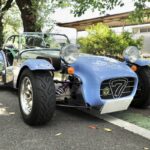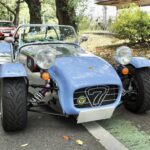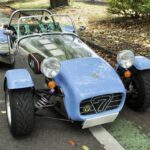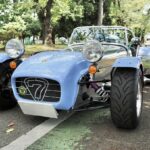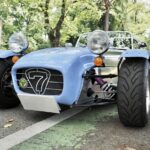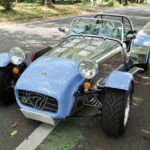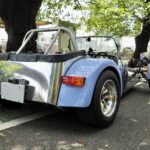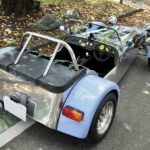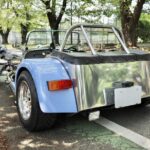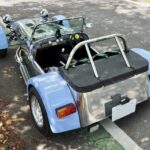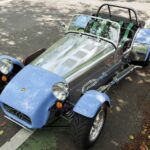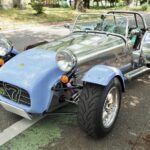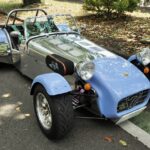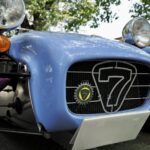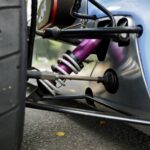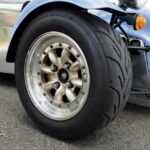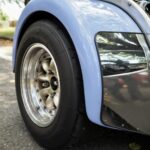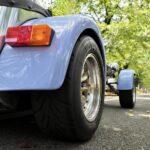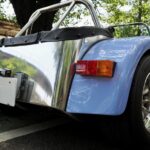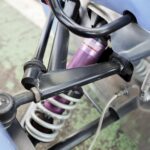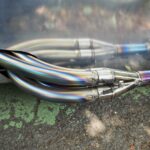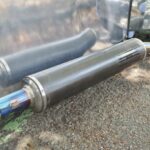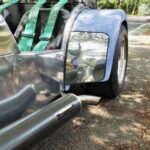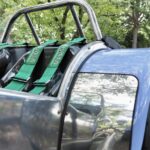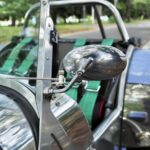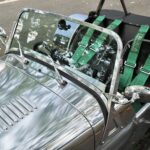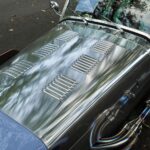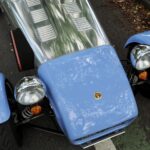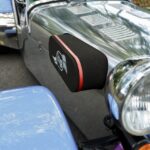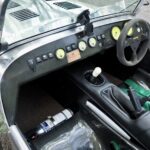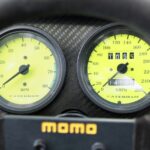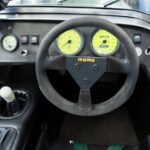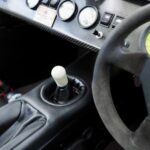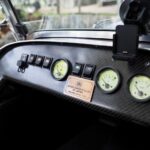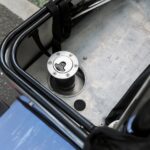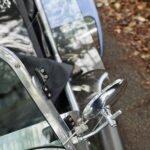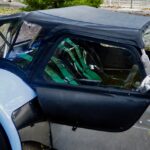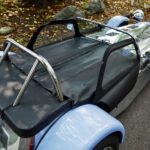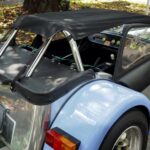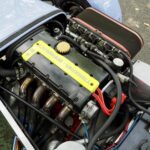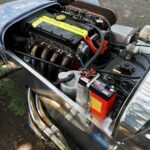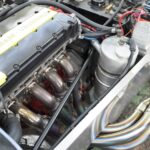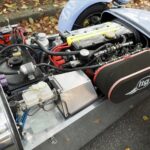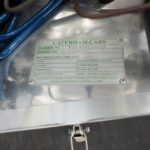TOP>Stock List>1995model Caterham Super Seven JPE Racing Evolution
1995model
Caterham Super Seven JPE Racing Evolution
↑↑↑Please watch the archived video above with audio if possible...
The ultimate rocket-like acceleration that leaves behind everything in your daily life is incredibly captivating...! A 1995 Caterham Super Seven JPE Racing Evolution is something you will never find, no matter how hard you search... It was the ultimate Seven, one that you could only wait for a chance to encounter...!
The moment the engine starts, an extraordinary sound pressure reverberates through your entire body, shaking the air around you. As someone who has been continuously captivated by the various high-power engines fitted into high-spec Sevens, this JPE, which has received domestic certification despite being a circuit-only machine, produces a sound that is in a league of its own. Just listening to it fills your brain with adrenaline… That sound was truly the breath of a racing machine echoing through the circuit…!
For seasoned Seven drivers, the ultimate Seven is undoubtedly the JPE (Jonathan Palmer Evolution), a model that far surpasses even the latest high-power versions. Introduced about 30 years ago in 1993, it was an icon of aspiration, with only 53 units ever released globally, making it extraordinarily rare. Now, before my eyes, stands the “JPE Racing Evolution,” an even more refined version of the JPE, shrouded in mystery but clearly one of the few in existence. Despite its track-only specs, Kiwa Trading obtained official certification upon import, allowing it to be driven on public roads—a model of extreme rarity.
The style of this car differs slightly from the commonly known JPE, closer to the original Lotus Super Seven Series 3. After suffering damage while parked, the owner had it fully reassembled according to his preferences. It underwent a complete refresh from chassis to body panels and cowls at a famous specialist shop in Saitama, resulting in a car that, more than a quarter of a century after its release in 1995, is now in almost new condition.
Thanks to the kindness of the owner, I was invited to sit in the passenger seat to experience this racing machine that can legally drive on public roads—the ultimate JPE.
The sight of the fluorescent yellow gauges lined up on the dry carbon meter panel always gets my heart racing. The rev counter, painted green from 6,500 to 8,000 rpm, along with the odometer showing 14,148 km, and the speedometer marked up to 260 km/h in 20 km/h increments, is a thrilling display. I flicked the kill switch located under the bulkhead, just above the right knee, pressed the push-button starter, and the 2.0L Vauxhall racing engine roared to life with that signature high-compression sound!
Sitting in the fully carbon Tillet seat, I fastened the 6-point harness from TAKATA, selected by the owner, and peered through the quick-release Momo steering wheel, feeling my excitement build as I gazed at the fluorescent yellow gauges.
The torquey 2.0L Vauxhall racing engine, combined with the Seven’s lightweight body, was surprisingly manageable—thanks, perhaps, to the easy handling of the Alpha Weber fuel injection system. As long as the proper gear was selected, it felt easy to control even at low speeds. Accompanied by the unique sound of the straight-cut gears, the JPE Racing Evolution smoothly rolled forward. The clutch, modified to a wire operation by the owner for improved reliability, was incredibly light and dramatically changed the overall feel of the car.
Apart from the phenomenal sound pressure from the low to mid-range, and its undeniable aura, the JPE behaved much like a regular Seven… Until that moment…!
The JPE Racing Evolution broke through the wall of air and began accelerating… and in an instant, it shot forward!!!
Even as I fought to keep my head from being pulled back, trying to think clearly in the moment (though thinking clearly in such a situation is utterly impossible), the engine revved to 7,000 rpm in one massive surge of energy not found in modern engines. As it hit the redline, the front wheels lifted from the ground—a rocket, no, a fighter jet—and with acceleration unlike anything you’d ever experience in daily life, my head was thrown far back, and the scenery before me melted from points into lines, rushing by in a blur!
In that ultimate cockpit… a strange smile crept across my face, and it became clear: this was no ordinary high-spec Seven!
Then… the smoothness of the ride was astonishing! With the wide-track double wishbone suspension specially designed for the JPE and the Aragosta dampers chosen by the owner, this machine rode with incredible fluidity. The brakes, equipped with 4-pot calipers, were powerful enough to set a record by beating the Ferrari F40 by three seconds in a 0-100-0 mph test, delivering superb stopping power! The feedback from the steering and from directly under the seat was so precise, it felt like you could converse with the car itself, immersing yourself completely in the drive.
The owner, a member of a famous Super Seven club and a true devotee to the Seven’s charm, smiled as he said, “Even now, this is only about 3,000 rpm… Beyond 4,000 rpm, the front lifts, and it revs all the way to 7,000… Honestly, it’s faster than a 12-cylinder Lamborghini… though I don’t often get to fully floor it.” This is the essence of JPE’s appeal—an extraordinary experience that makes you fall in love with the drive!
Although the JPE’s 0-60 mph record was later surpassed by the McLaren F1, the fact that it once held the world record speaks to its overwhelming presence, a presence that continues to captivate hearts even after more than a quarter of a century.
Before I knew it, I had taken over 400 photos, and my notes from the interview were an unintelligible mess of excitement… That’s how enthralling the ultimate rocket-like acceleration was, an experience that left all of daily life behind. The 1995 Caterham Super Seven JPE Racing Evolution is something you’ll never find, no matter how hard you search… It was truly a super Seven, waiting for that ultimate chance encounter.
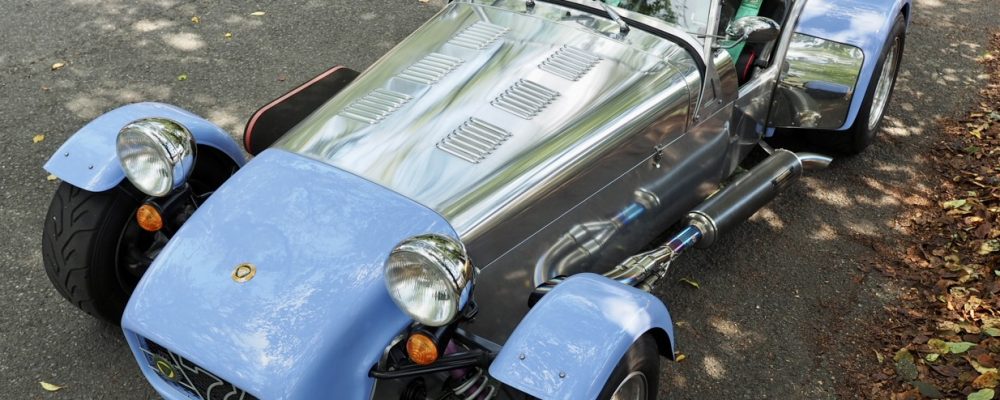
To build the most extreme and high-performance Seven...!" This dream, envisioned by Caterham's young engineers, was executed with no regard for cost, and their passion led to a connection with former F1 driver Jonathan Palmer...! Thus, the Caterham Super Seven JPE (Jonathan Palmer Evolution) was unleashed upon the world!
Caterham Super Seven JPE… It’s a machine that emits an otherworldly performance and a divine aura, a car that surpasses even the current fastest models and remains the most unforgettable in Caterham’s history for enthusiasts, doesn’t it? I, too, am one of those enthusiasts… To me, the car magazines that featured the JPE when it was announced are keepsakes to be treasured forever… I can vividly recall the articles I’ve read over and over, especially the photo of it counter-steering out of a corner, lifting the front and launching forward aggressively…
Between mid-1993 and mid-1995, only 53 units of the JPE were assembled by Caterham engineers Gary May and Perry Smith. Of these, just seven left-hand-drive models were exported to Europe and North America, with around ten staying in the UK, and the rest delivered to France and Japan, making it an incredibly rare car.
Despite its limited production, the JPE is a name known not just to Seven enthusiasts. Though a road car, it set world speed records for 0-60 mph and 0-100-0 mph (miles), among others, at the time. It became a precursor to the super high-spec Sevens that we see today, leaving an indelible mark in the memories of car enthusiasts worldwide.
Named the JPE (Jonathan Palmer Evolution) because British racer Jonathan Palmer, who retired from F1 after the 1989 season driving the Tyrrell 018, was involved in its development, the Caterham’s racing evolution model had its engine tuned by Swindon Racing Engines, who specialize in Vauxhall engines. This tuning elevated its power by a staggering 50 horsepower over the standard Vauxhall-powered Seven, delivering 250 horsepower. With an incredible power-to-weight ratio of over 500 horsepower per ton, the car’s front lifts at over 4000 rpm, accelerating like a rocket—truly the fastest car in the world.
On Monday, March 8, 1993, at the Millbrook vehicle test facility in Bedfordshire, England, one JPE, prepared to break records, lined up on the one-mile straight. Revving up to the peak torque of 6250 rpm, it launched with a racing start, unleashing its full potential.
With the accelerator fully pressed to the bulkhead, it maintained 7000 rpm until it reached 55 mph (88.5 km/h), where the speed of the rear tires finally matched the forward velocity. Just before the limiter kicked in, shifting to second gear, it hit 60 mph (96.5 km/h) in only 3.46 seconds—surpassing the world record for 0-60 mph, even beating the Ferrari F40, which was hailed as the fastest at the time!
Considering the current environment surrounding car design, with various regulations impacting automobile manufacturing, it’s unlikely that such a car will ever be made again. The JPE was born in an era right before emission regulations and single vehicle type approvals began to affect small-scale manufacturers like Caterham. This JPE was created by the bold vision of two young men, Andy Noble, who would later serve as Caterham’s marketing director, and Jez Coates, who became the technical director. Their vision? “To create the most extreme, high-performance Seven.”
Profit forecasts, sales estimates, and calculations of losses can often stifle brilliant ideas in not just the automobile industry, but the world of business as a whole. Perhaps the early 1990s were just barely a good time for such ventures, because this project started with Andy and Jez declaring, “Let’s do it!” without any meetings to discuss development costs, presentations explaining sales forecasts to executives like Graham Nearn, and no concerns about anything except for the thrill of the challenge.
The two of them, working at Caterham, would stay late into the night after their regular duties, assembling test models and racing on weekends. They’d then return to the factory to work on improvements, fully dedicated to creating this special Seven. This is something unimaginable in today’s environment, but at the time, the project lacked any cost controls, and the two of them were simply pushing ahead with the sole goal of creating “the most extreme, high-performance Seven.” As long as the company made a profit and Graham Nearn, the owner, gave his approval, their passion and brilliant idea for the “most extreme, high-performance Seven” could continue moving forward.
The two men took the 170-horsepower Vauxhall 2.0L twin-cam engine used in the fastest Caterham model at the time, the HPC, to Swindon Racing Engines and requested its development into a racing engine. Disregarding costs, as mentioned earlier, the Vauxhall racing engine alone had a purchase price of £34,950 (roughly 6.7 million yen at current exchange rates!), which was about three times the cost of the HPC engine. The tuning was intense: precision cylinder honing to house ultralight Cosworth pistons operating with a 12:1 compression ratio, racing camshafts, Cosworth-designed air intakes, and an Alpha Weber injection system—all of which produced an incredible 250 PS at 7750 rpm and 25.8 kgm of torque at 6250 rpm, extraordinary for a road car.
This engine was then mounted onto a lightweight, durable racing frame. The vision of the two young men at Caterham—creating “the most extreme, high-performance Seven”—was finally realized. The final setup was done by Jonathan Palmer, a former F1 driver, who fine-tuned it into the “ultimate road-going Seven.”
It was fate that brought the two Caterham employees and Jonathan Palmer together. After retiring from F1 in 1989, Palmer had just launched his sports driving experience business in 1991 and was in talks with Caterham to provide demonstration cars for his programs. Andy Noble, who already knew Palmer from a previous Ford corporate event, invited Palmer to join the JPE development. Their friendship led Palmer to offer his cooperation for free, providing invaluable support to the project.
Thus, with the two men’s passion and Palmer’s fine-tuning, the most extreme, high-performance Seven, equipped with a Vauxhall engine and a lightweight, durable chassis, was christened JPE (Jonathan Palmer Evolution) and unveiled at the 1992 British Motor Show. In the UK, the initial buyers had the opportunity to ride in the passenger seat with Palmer on the track, witnessing firsthand just how extreme and high-performance the JPE was. At that time, Caterham Cars President Graham Nearn told the media, “This super Seven is the ultimate road-going car for challengers. It far outperforms supercars in every way, at a fraction of the price, making it the best value-for-performance car.” This story has become a well-known legend.
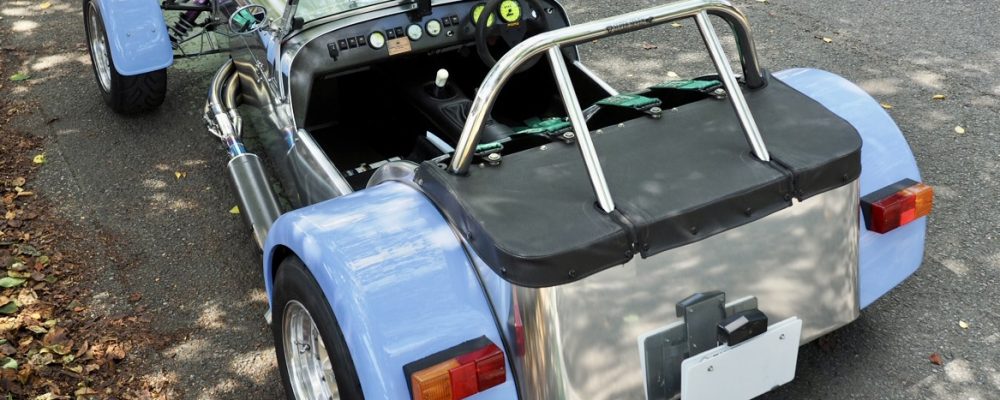
After covering the 1995 Caterham Super Seven JPE Racing Evolution...
Even several days after the interview, the sensation of that rocket-like acceleration, something you don’t experience in everyday life, lingers as a cherished memory. The JPE Racing Evolution truly is an extraordinary machine.
The owner, who thoroughly enjoys outdoor life with his family in a large camper, is someone who had long dreamed of owning a Lamborghini after witnessing the wave of supercars that flooded into Japan during his childhood. Eventually, he made that dream a reality.
But just before achieving his Lamborghini dream, he “took a little detour” and dove headfirst into the world of the Super Seven. Starting with a Birkin Seven, he then transitioned to a Caterham Super Seven Classic. Although the Classic, with its easy-going, anywhere-you-can-go nature, brought much joy, the desire for something more extreme never faded. This led to the acquisition of the JPE Racing Evolution—a car he stumbled upon by chance but had always admired. Since then, he has fully enjoyed the ultimate Seven lifestyle.
He mentioned only testing its full power on the circuit once or twice. Mainly, he participates in club-hosted events and tours, including trips to Hakone Turnpike. Being family-oriented, the owner also installed a heater unit—despite the added weight—to ensure his wife could enjoy winter trips to hot springs in comfort.
Although the chassis, body panels, and cowl have all been refreshed in recent years, the JPE Racing Evolution remains pristine. The owner proudly admitted, “I love driving it, but I probably enjoy polishing and gazing at it even more!” I can completely relate to that sentiment. Valuing its presence in the garage, he even equipped the cockpit with a charging port to connect a trickle charger when not driving it. And then, there’s the trusted mechanic who knows the car inside out and plays an essential role in its maintenance. “Even if I haven’t driven it much, he calls me up and insists I bring it in for an oil change,” the owner remarked. He also owns a dedicated trailer for the Seven, ensuring the car is always meticulously maintained.
This is truly a well-cared-for masterpiece. Throughout the interview, the owner frequently glanced at the JPE with a soft smile on his face. Due to changing circumstances, he is sadly parting with the car, though with a heavy heart. “This is an incredibly rare and exceptional Seven. I hope the next owner will take great care of it,” he said.
“The ultimate rocket-like acceleration that leaves everyday life behind—it’s unbelievably addictive! You won’t find another 1995 Caterham Super Seven JPE Racing Evolution anywhere. It’s the ultimate Seven, and you’ll have to wait for that perfect encounter!”
I encourage anyone interested in this extraordinary Super Seven to visit Gunma Prefecture and see it for yourself.
This extremely rare and pristine 1995 Caterham Super Seven JPE Racing Evolution is currently located in Gunma Prefecture.
Since this is a private transaction, no consumption tax or additional fees will be applied. However, the buyer will be responsible for pro-rated vehicle tax (annual amount: ¥39,500) and the recycling deposit fee (¥9,620). Additionally, the buyer is asked to arrange for transportation of the vehicle. However, my company also provides classic car transport services using our own carrier trucks, so please feel free to reach out if you would like assistance.
【For Inquiries…】
This vehicle is listed on the cross-border e-commerce platform for classic and collectible cars, Estate Sale Supremacy®.
What is Estate Sale Supremacy®?
Estate Sale Supremacy® introduces vehicles filled with the owner’s passion, presented through detailed interviews, articles, and videos. Inspired by the North American estate sale culture, it serves as a Japanese version, aiming to preserve memories while passing down cherished vehicles to the next generation. Unlike low-ball purchases that leave little behind, we honor the owner’s story and ensure a smooth transition of ownership.
We conduct thorough interviews with the current owner regarding maintenance records and repair history, including any past accidents. In cases of significant accidents or if the owner’s history with the vehicle is unclear, we decline to publish the listing to ensure peace of mind for prospective buyers.
This article is based on an interview with the owner conducted on August 18, 2024, under clear skies from 1:00 PM to 4:00 PM. As this was a limited-time interview, please note that the condition of the vehicle may not be 100% accurately reflected, and some subjective opinions based on the weather and interviewer’s impressions are included.
If you have questions about the vehicle or would like to arrange an in-person viewing, please use the contact form at the bottom of this page. Since this is a private sale, we kindly ask that only serious buyers who are considering purchase contact us for a viewing.
Thank you for your consideration.







